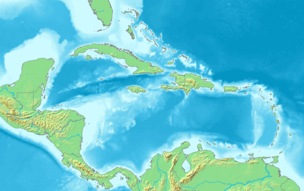Milwaukee Deep
Milwaukee Deep, also known as the Milwaukee Depth, is part of the Puerto Rico Trench.[1] Together with the surrounding area, known as Brownson Deep, the Milwaukee Deep forms an elongated depression that constitutes the floor of the trench. As there is no geomorphological distinction between the two, it has been proposed that the use of both names to refer to distinct areas should be reviewed.[2]


The floor of the Puerto Rico Trench constitutes the deepest point in the Atlantic Ocean. During the Five Deeps Expedition, explorer Victor Vescovo achieved the first manned descent to this location. Media outlets overwhelmingly referred to the area as the Brownson Deep,[3][4][5] while the name Milwaukee Deep was used by others.[6] However, likely due to the factors mentioned above, the expedition has not used any particular name to refer to the site of their Atlantic dive.[7]
The Puerto Rico Trench has a maximum depth of no more than 8,376 metres (27,480 ft), as measured to be the deepest point in the Atlantic Ocean by Vescovo during his descent.[7] Previously, however, the depth of the Milwaukee Deep (when being used to refer to the Atlantic's deepest point) had been reported by various sources as 8,710 metres (28,580 ft),[8] 8,740 metres (28,670 ft),[2] or 8,750 metres (28,710 ft).[1] It is just 76.0 miles (122.3 km) north of the coast of Puerto Rico at Punto Palmas Altas in Manatí.[9][10]
History
The ocean floor feature is named for the USS Milwaukee (CL-5), a U.S. Navy Omaha class cruiser, which discovered the Milwaukee Deep on February 14, 1939 with a reading of 28,680 feet (8,740 m).[11][12] On August 19, 1952, the U.S. Fish and Wildlife vessel Theodore N. Gill obtained a reading of 28,560 feet (8,710 m) at (19°36′N 68°19′W), virtually identical with the Milwaukee's reading. By then, the existence of deep water to the Atlantic Ocean side of the Caribbean had been known for more than a century.
One of the area's earliest soundings was obtained June 12, 1852 by Lt. S. P. Lee, U.S. Navy brig Dolphin, with a reading of 22,950 feet (7,000 m) at (26°32′N 60°06′W).[8]
In 1964, the French submersible Archimede explored the Puerto Rico Trench to a depth of approximately 8,300 metres (27,200 ft).[13]
On October 21, 2018, explorer Victor Vescovo, aboard the DSV Limiting Factor, became the first person to reach the bottom of the deep. This made the Limiting Factor the deepest diving operational submersible at the time.[13]
References
- Vaughan, T. Wayland; et al. (1940). "Chart I. - Major Ocean Basins with Depths Exceeding 4000 meters (I-XLV)" (PDF). earthguide.ucsd.edu. Retrieved 2014-08-25.
- Stewart, Heather Ann (October 2019). "The five deeps: The location and depth of the deepest place in each of the world's oceans". Earth-Science Reviews. 197:102896: 102896. Bibcode:2019ESRv..19702896S. doi:10.1016/j.earscirev.2019.102896 – via ResearchGate.
- "Exploring the Deepest Points on Planet Earth". hydro-international.com. Retrieved 2020-01-24.
- "The last of the great explorers, The last of the great explorers". The Economist. ISSN 0013-0613. Retrieved 2020-01-24.
- Raza, Azra (2019-11-10). "The last of the great explorers". 3 Quarks Daily. Retrieved 2020-01-24.
- "Victor Vescovo record-setting quest to reach the bottom of each ocean". Popular Science. Retrieved 2020-01-24.
- "Atlantic Ocean". Five Deeps Expedition. Retrieved 2020-01-24.
- Lyman, J. (1954-03-18). "The Deepest Sounding in the North Atlantic". Proceedings of the Royal Society of London. Series A. Mathematical and Physical Sciences. 222 (1150): 334–336. Bibcode:1954RSPSA.222..334L. doi:10.1098/rspa.1954.0075. JSTOR 99222.
- "Milwaukee Depth". Encyclopædia Britannica. 2009. Encyclopædia Britannica Online. 12 October 2009 <http://www.britannica.com/EBchecked/topic/383165/Milwaukee-Depth>.
- Bulent Kastarlak (1958). "Low Cost Housing Development with Aided Self-Help Method in Bayamon, Commonwealth of Puerto Rico" (PDF). dspace.mit.edu. Archived from the original (PDF) on 2014-08-26. Retrieved 2014-08-25.
- Vaughn; et al. (1940). "Chapter II: The Earth and its Ocean Basins" (PDF). earthguide.ucsd.edu. Retrieved 2014-08-25.
- Silverstone, Paul (2008). The Navy of World War II: 1922-1947.
- "Atlantic Ocean". Five Deeps Expedition. Retrieved 2020-01-24.